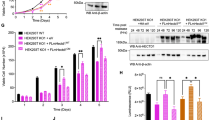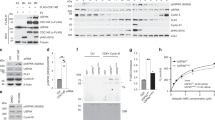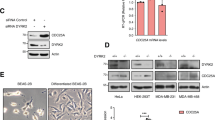Abstract
Cell-cycle transition from the G2 phase into mitosis is regulated by the cyclin-dependent protein kinase 1 (CDK1) in complex with cyclin B. CDK1 activity is controlled by both inhibitory phosphorylation, catalysed by the Myt1 and Wee1 kinases, and activating dephosphorylation, mediated by the CDC25 dual-specificity phosphatase family members. In somatic cells, Wee1 is downregulated by phosphorylation and ubiquitin-mediated degradation to ensure rapid activation of CDK1 at the beginning of M phase. Here, we show that downregulation of the regulatory β-subunit of protein kinase CK2 by RNA interference results in delayed cell-cycle progression at the onset of mitosis. Knockdown of CK2β causes stabilization of Wee1 and increased phosphorylation of CDK1 at the inhibitory Tyr15. PLK1–Wee1 association is an essential event in the degradation of Wee1 in unperturbed cell cycle. We have found that CK2β participates in PLK1–Wee1 complex formation whereas its cellular depletion leads to disruption of PLK1–Wee1 interaction and reduced Wee1 phosphorylation at Ser53 and 121. The data reported here reinforce the notion that CK2β has functions that are independent of its role as the CK2 regulatory subunit, identifying it as a new component of signaling pathways that regulate cell-cycle progression at the entry of mitosis.
This is a preview of subscription content, access via your institution
Access options
Subscribe to this journal
Receive 50 print issues and online access
$259.00 per year
only $5.18 per issue
Buy this article
- Purchase on SpringerLink
- Instant access to full article PDF
Prices may be subject to local taxes which are calculated during checkout








Similar content being viewed by others
References
Bibby A, Litchfield DW . (2005). The multiple personalities of the regulatory subunit of protein kinase CK2: CK2 dependent and CK2 independent roles reveal a secret identity for CK2beta. Int J Biol Sci 1: 67–79.
Boutros R, Dozier C, Ducommun B . (2006). The when and wheres of CDC25 phosphatases. Curr Opin Cell Biol 18: 185–191.
Busino L, Chiesa M, Draetta GF, Donzelli M . (2004). Cdc25A phosphatase: combinatorial phosphorylation, ubiquitylation and proteolysis. Oncogene 23: 2050–2056.
Coleman TR, Tang Z, Dunphy WG . (1993). Negative regulation of the wee1 protein kinase by direct action of the nim1/cdr1 mitotic inducer. Cell 72: 919–929.
Faust M, Montenarh M . (2000). Subcellular localization of protein kinase CK2. A key to its function? Cell Tissue Res 301: 329–340.
Glover CV . (1998). On the physiological role of casein kinase II in Saccharomyces cerevisiae. Prog Nucleic Acid Res Mol Biol 59: 95–133.
Guerra B, Issinger O-G, Wang JYJ . (2003). Modulation of human checkpoint kinase Chk1 by the regulatory beta-subunit of protein kinase CK2. Oncogene 22: 4933–4942.
Guerra B, Siemer S, Boldyreff B, Issinger O-G . (1999). Protein kinase CK2: evidence for a protein kinase CK2beta subunit fraction, devoid of the catalytic CK2alpha subunit, in mouse brain and testicles. FEBS Lett 462: 353–357.
Karlsson-Rosenthal C, Millar JB . (2006). Cdc25: mechanisms of checkpoint inhibition and recovery. Trends Cell Biol 16: 285–292.
Katayama K, Fujita N, Tsuruo T . (2005). Akt/protein kinase B-dependent phosphorylation and inactivation of WEE1Hu promote cell cycle progression at G2/M transition. Mol Cell Biol 25: 5725–5737.
Kohn EA, Yoo CJ, Eastman A . (2003). The protein kinase C inhibitor Gö6976 is a potent inhibitor of DNA damage-induced S and G2 cell cycle checkpoints. Cancer Res 63: 31–35.
Kreutzer J, Guerra B . (2007). The regulatory beta-subunit of protein kinase CK2 accelerates the degradation of CDC25A phosphatase through the checkpoint kinase Chk1. Int J Oncol 31: 1251–1259.
Kurki S, Peltonen K, Latonen L, Kiviharju TM, Ojala PM, Meek D et al. (2004). Nucleolar protein NPM interacts with HDM2 and protects tumor suppressor protein p53 from HDM2-mediated degradation. Cancer Cell 5: 465–475.
Litchfield DW . (2003). Protein kinase CK2: structure, regulation and role in cellular decisions of life and death. Biochem J 369: 1–15.
Lüscher B, Litchfield DW . (1994). Biosynthesis of casein kinase II in lymphoid cell lines. Eur J Biochem 220: 521–526.
Mailand N, Falck J, Lukas C, Syljuåsen RG, Welcker M, Bartek J et al. (2000). Rapid destruction of human Cdc25A in response to DNA damage. Science 288: 1425–1429.
Molinari M, Mercurio C, Dominguez J, Goubin F, Draetta GF . (2000). Human Cdc25A inactivation in response to S phase inhibition and its role in preventing premature mitosis. EMBO Rep 1: 71–79.
Parker LL, Walter SA, Young PG, Piwnica-Worms H . (1993). Phosphorylation and inactivation of the mitotic inhibitor Wee1 by the nim1/cdr1 kinase. Nature 363: 736–738.
Perry JA, Kornbluth S . (2007). Cdc25 and Wee1: analogous opposites? Cell Div 2: 12.
Pines J . (1999). Four-dimensional control of the cell cycle. Nat Cell Biol 1: E73–E79.
Seeber S, Issinger O-G, Holm T, Kristensen LP, Guerra B . (2005). Validation of protein kinase CK2 as oncological target. Apoptosis 10: 875–885.
Sia RA, Bardes ESG, Lew DJ . (1998). Control of Swe1p degradation by the morphogenesis checkpoint. EMBO J 17: 6678–6688.
Stalter G, Siemer S, Becht E, Ziegler M, Remberger K, Issinger OG . (1994). Asymmetric expression of protein kinase CK2 subunits in human kidney tumors. Biochem Biophys Res Commun 202: 141–147.
Sørensen CS, Syljuåsen RG, Falck J, Schroeder T, Ronnstrand L, Khanna KK et al. (2003). Chk1 regulates the S phase checkpoint by coupling the physiological turnover and ionizing radiation-induced accelerated proteolysis of Cdc25A. Cancer Cell 3: 247–258.
Tang Z, Coleman TR, Dunphy WG . (1993). Two distinct mechanisms for negative regulation of the Wee1 protein kinase. EMBO J 12: 3427–3436..
Timofeeva OA, Plisov S, Evseev AA, Peng S, Jose-Kampfner M, Lovvorn HN et al. (2006). Serine-phosphorylated STAT1 is a prosurvival factor in Wilms’ tumor pathogenesis. Oncogene 25: 7555–7564.
Toczyski DP, Galgoczy DJ, Hartwell LH . (1997). CDC5 and CKII control adaptation to the yeast DNA damage checkpoint. Cell 90: 1097–1106.
van Vugt MA, Bras A, Medema RH . (2004). Polo-like kinase-1 controls recovery from a G2 DNA damage-induced arrest in mammalian cells. Mol Cell 15: 799–811.
Watanabe N, Arai H, Iwasaki J-i, Shiina M, Ogata K, Hunter T et al. (2005). Cyclin-dependent kinase (CDK) phosphorylation destabilizes somatic Wee1 via multiple pathways. Proc Natl Acad Sci USA 102: 11663–11668.
Watanabe N, Arai H, Nishihara Y, Taniguchi M, Watanabe N, Hunter T et al. (2004). M-phase kinases induce phospho-dependent ubiquitination of somatic Wee1 by SCFbeta-TrCP. Proc Natl Acad Sci USA 101: 4419–4424.
Wu L, Russell P . (1993). Nim1 kinase promotes mitosis by inactivating Wee1 tyrosine kinase. Nature 363: 738–741.
Xiao Z, Chen Z, Gunasekera AH, Sowin TJ, Rosenberg SH, Fesik S et al. (2003). Chk1 mediates S and G2 arrests through Cdc25A degradation in response to DNA-damaging agents. J Biol Chem 278: 21767–21773.
Yamane K, Kinsella TJ . (2005). CK2 inhibits apoptosis and changes its cellular localization following ionizing radiation. Cancer Res 65: 4362–4367.
Zhao H, Watkins JL, Piwnica-Worms H . (2002). Disruption of the checkpoint kinase 1/cell division cycle 25A pathway abrogates ionizing radiation-induced S and G2 checkpoints. Proc Natl Acad Sci USA 99: 14795–14800.
Acknowledgements
We thank T Holm for technical assistance. This study was supported by the Novo Nordisk Foundation, grant no. 5373 and the Danish Medical Research Council, grant no. 271-07-0464 to BG.
Author information
Authors and Affiliations
Corresponding author
Rights and permissions
About this article
Cite this article
Yde, C., Olsen, B., Meek, D. et al. The regulatory β-subunit of protein kinase CK2 regulates cell-cycle progression at the onset of mitosis. Oncogene 27, 4986–4997 (2008). https://doi.org/10.1038/onc.2008.146
Received:
Revised:
Accepted:
Published:
Issue Date:
DOI: https://doi.org/10.1038/onc.2008.146



